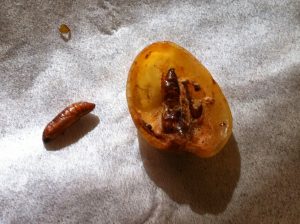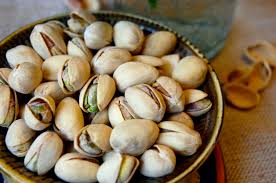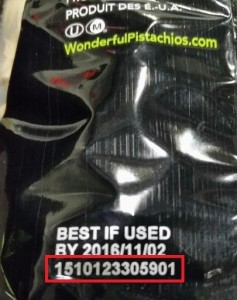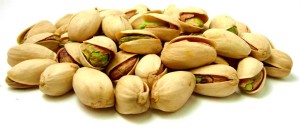Keeping with the small-town southern Ontario theme (that’s still in Canada) Chris Sperduti, 29, from Bolton (not to be confused with Beeton) grabbed a handful of pistachios and was shelling them when he came across something that turned his stomach.
 There were bugs nested in two of the shells. He could see holes in the nuts where the bugs had eaten some of his snack.
There were bugs nested in two of the shells. He could see holes in the nuts where the bugs had eaten some of his snack.
Karen Martin-Robbins of the Caledon Enterprise writes the Bolton man contacted Walmart in Bolton – not so small anymore if it has a Walmart — where he bought the product — the company gave him his money back and a savings coupon for more pistachios.
They also told him that with agricultural produce, you can expect to get some insects.
He was even more grossed out by that.
“When I’m eating pistachios, I expect to be eating pistachios. Not bugs,” he said.
Then, he went to Costco to buy his pistachios.
He found three more bugs in his first handful.
A quantitative risk assessment of human salmonellosis from consumption of pistachios in the United States
Journal of Food Protection vol. 81 no. 6
SOFIA M. SANTILLANA FARAKOS,1* RÉGIS POUILLOT,1 GORDON R. DAVIDSON,1 RHOMA JOHNSON,1 JUDITH SPUNGEN,1INSOOK SON,1 NATHAN ANDERSON,2 and JANE M. VAN DOREN1
https://doi.org/10.4315/0362-028X.JFP-17-379
http://jfoodprotection.org/doi/abs/10.4315/0362-028X.JFP-17-379?code=fopr-site
We developed a quantitative risk assessment model to assess the risk of human nontyphoidal salmonellosis from consumption of pistachios in the United States and to evaluate the impact of Salmonella treatments (1- to 5-log reductions). The exposure model estimating prevalence and contamination levels of Salmonella at consumption included steps in pistachio processing such as transport from grower to huller, removal of the hull through wet abrasion, separation of pistachio floaters (immature, smaller nuts) and sinkers (mature, larger nuts) in a flotation tank, drying, storage, and partitioning. The risks of illness per serving and per year were evaluated by including a Salmonella dose-response model and U.S. consumption data. The spread of Salmonella through float tank water, delay in drying resulting in growth, increased Salmonella levels through pest infestation during storage (pre- and posttreatment), and a simulation of the 2016 U.S. salmonellosis outbreak linked to consumption of pistachios were the modeled atypical situations.
 The baseline model predicted one case of salmonellosis per 2 million servings (95% CI: one case per 5 million to 800,000 servings) for sinker pistachios and one case per 200,000 servings (95% CI: one case per 400,000 to 40,000 servings) for floater pistachios when no Salmonella treatment was applied and pistachios were consumed as a core product (>80% pistachio) uncooked at home. Assuming 90% of the pistachio supply is sinkers and 10% is floaters, the model estimated 419 salmonellosis cases per year (95% CI: 200 to 1,083 cases) when no Salmonella treatment was applied. A mean risk of illness of less than one case per year was estimated when a minimum 4-log reduction treatment was applied to the U.S. pistachio supply, similar to the results of the Salmonella risk assessment for almonds. This analysis revealed that the predicted risk of illness per serving is higher for all atypical situations modeled compared with the baseline, and delay in drying had the greatest impact on consumer risk.
The baseline model predicted one case of salmonellosis per 2 million servings (95% CI: one case per 5 million to 800,000 servings) for sinker pistachios and one case per 200,000 servings (95% CI: one case per 400,000 to 40,000 servings) for floater pistachios when no Salmonella treatment was applied and pistachios were consumed as a core product (>80% pistachio) uncooked at home. Assuming 90% of the pistachio supply is sinkers and 10% is floaters, the model estimated 419 salmonellosis cases per year (95% CI: 200 to 1,083 cases) when no Salmonella treatment was applied. A mean risk of illness of less than one case per year was estimated when a minimum 4-log reduction treatment was applied to the U.S. pistachio supply, similar to the results of the Salmonella risk assessment for almonds. This analysis revealed that the predicted risk of illness per serving is higher for all atypical situations modeled compared with the baseline, and delay in drying had the greatest impact on consumer risk.




